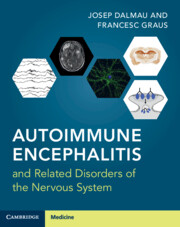Book contents
- Autoimmune Encephalitis and Related Disorders of the Nervous System
- Autoimmune Encephalitis and Related Disorders of the Nervous System
- Copyright page
- Dedication
- Contents
- Clinical Vignettes
- Videos
- Preface
- Abbreviations
- Section 1 Overview
- Section 2 Antibodies and Antigens
- Chapter 4 Antibodies to Intracellular Antigens in CNS Disorders
- Chapter 5 Antibodies to Neural Cell Surface Antigens
- Section 3 Specific Syndromes and Diseases
- Section 4 Autoimmunity in Neurological and Psychiatric Diseases
- Index
- References
Chapter 4 - Antibodies to Intracellular Antigens in CNS Disorders
from Section 2 - Antibodies and Antigens
Published online by Cambridge University Press: 27 January 2022
- Autoimmune Encephalitis and Related Disorders of the Nervous System
- Autoimmune Encephalitis and Related Disorders of the Nervous System
- Copyright page
- Dedication
- Contents
- Clinical Vignettes
- Videos
- Preface
- Abbreviations
- Section 1 Overview
- Section 2 Antibodies and Antigens
- Chapter 4 Antibodies to Intracellular Antigens in CNS Disorders
- Chapter 5 Antibodies to Neural Cell Surface Antigens
- Section 3 Specific Syndromes and Diseases
- Section 4 Autoimmunity in Neurological and Psychiatric Diseases
- Index
- References
Summary
Antibodies against neural intracellular antigens have been classified in three groups: (1) markers of paraneoplastic neurological syndromes (onconeural antibodies) and therefore the presence of an underlying cancer; (2) markers of non-paraneoplastic neurological syndromes; and (3) markers of autoimmune retinopathies. All antibodies against neural intracellular proteins recognize linear epitopes, are detected by immunoblot, and are considered non-pathogenic. An exception is the amphiphysin antibodies that can potentially reach the antigen that is briefly exposed to the extracellular space during the process of synaptic vesicle recycling. The most common onconeural antibodies are Hu (markers of paraneoplastic neurological syndromes associated with small-cell lung cancer), Yo (paraneoplastic cerebellar degeneration and breast and ovarian cancer), and Ma2 (limbic and brainstem encephalitis with testicular seminomas). The two most common antibodies present in non-paraneoplastic CNS syndromes are glutamic acid decarboxylase (GAD) and glial fibrillary acidic protein (GFAP) antibodies. GAD antibodies are biomarkers of stiff-person syndrome and also occur in some patients with cerebellar ataxia or drug-resistant temporal lobe epilepsy. GFAP antibodies associate with meningoencephalitis and a broad spectrum of symptoms without a clear specific syndrome. Unlike the other antibodies against intracellular antigens that are usually detectable in serum and CSF, GFAP antibodies are predominantly detected in CSF.
Keywords
- Type
- Chapter
- Information
- Publisher: Cambridge University PressPrint publication year: 2022

